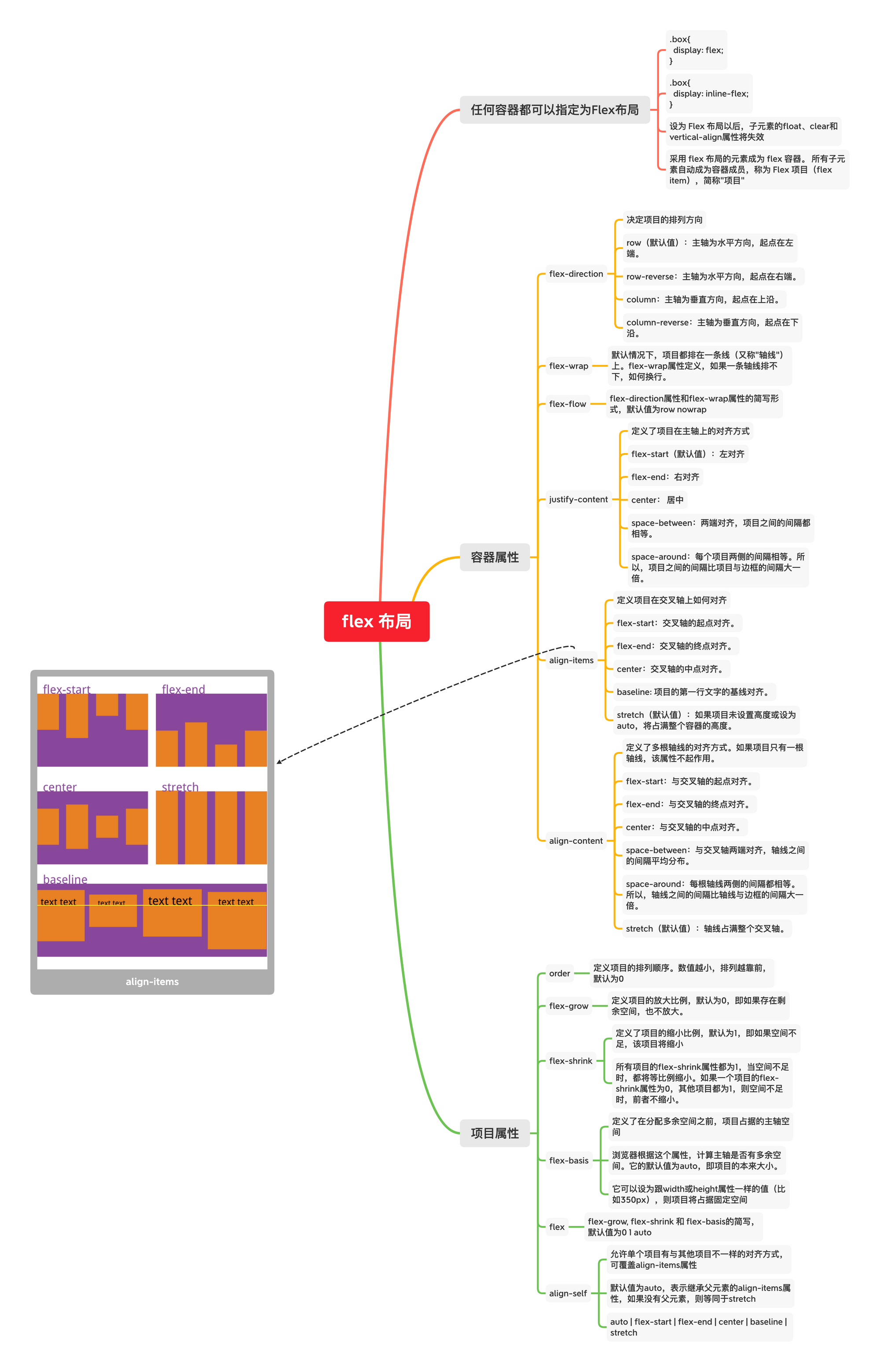# flex弹性布局
TIP
Flexible Box 模型,通常被称为 flexbox (opens new window),是一种一维的布局模型。它给 flexbox 的子元素之间提供了强大的空间分布和对齐能力。
flexbox 是一种一维的布局,是因为一个 flexbox 一次只能处理一个维度上的元素布局,一行或者一列。作为对比的是另外一个二维布局 CSS Grid Layout (opens new window),可以同时处理行和列上的布局。

# 父元素 (flex container)
- flex-direction
- flex-wrap
- flex-flow
- justify-content
- align-items
- align-content
# 一、两根轴线(flex-direction)
TIP
当使用 flex 布局时,首先想到的是两根轴线 — 主轴和交叉轴。主轴由 flex-direction (opens new window) 定义,另一根轴垂直于它。
# 1.1 主轴
主轴由 flex-direction 定义,可以取4个值:
.container {
flex-direction: row (default) | row-reverse | column | column-reverse;
}
- 如果你选择了
row或者row-reverse,你的主轴将沿着 inline 方向延伸。

- 选择
column或者column-reverse时,你的主轴会沿着上下方向延伸 — 也就是 block 排列的方向。

# 1.2 交叉轴
交叉轴垂直于主轴,所以如果你的flex-direction (主轴) 设成了 row 或者 row-reverse 的话,交叉轴的方向就是沿着列向下的。

如果主轴方向设成了 column 或者 column-reverse,交叉轴就是水平方向。

理解主轴和交叉轴的概念对于对齐 flexbox 里面的元素是很重要的;flexbox 的特性是沿着主轴或者交叉轴对齐之中的元素。
# 二、起始线和终止线
flexbox 不会对文档的书写模式提供假设。
- 如果
flex-direction是row,并且我是在书写英文,那么主轴的起始线是左边,终止线是右边。

- 如果我在书写阿拉伯文,那么主轴的起始线是右边,终止线是左边。

在这两种情况下,交叉轴的起始线是flex容器的顶部,终止线是底部,因为两种语言都是水平书写模式。
之后,你会觉得用起始和终止来描述比左右更合适,这会对你理解其他相同模式的布局方法(例如:CSS Grid Layout)起到帮助的作用。
# 三、flex-wrap
用flex-wrap实现多行Flex容器 (opens new window)
.container {
flex-wrap: nowrap (default) | wrap | wrap-reverse;
}
# 四、flex-flow
属性 flex-direction 和 flex-wrap 组合为简写属性 flex-flow (opens new window)。
语法:
.container { flex-flow: <flex-direction> | <flex-wrap> }
# 五、元素间的对齐和空间分配 (opens new window)
# 6.1 align-items
align-items (opens new window) 属性可以使元素在交叉轴方向对齐。
.container {
align-items: stretch | flex-start | flex-end | center | baseline | first baseline | last baseline | start | end | self-start | self-end + ... safe | unsafe;
}
# 6.2 justify-content
justify-content (opens new window)属性用来使元素在主轴方向上对齐,主轴方向是通过 flex-direction 设置的方向。初始值是flex-start,元素从容器的起始线排列。但是你也可以把值设置为flex-end,从终止线开始排列,或者center,在中间排列.
.container {
align-content: flex-start | flex-end | center | space-between | space-around | space-evenly | stretch | start | end | baseline | first baseline | last baseline + ... safe | unsafe;
}
下列justify-content属性的值:
stretchflex-startflex-endcenterspace-aroundspace-between
# 子元素(flex items)
项目的属性
以下6个属性设置在项目上:
order:属性定义项目的排列顺序。数值越小,排列越靠前,默认为0。flex-grow:属性定义项目的放大比例,默认为0,即如果存在剩余空间,也不放大。flex-shrink:属性定义了项目的缩小比例,默认为1,即如果空间不足,该项目将缩小。flex-basis:属性定义了在分配多余空间之前,项目占据的主轴空间(main size)。浏览器根据这个属性,计算主轴是否有多余空间。flex:是flex-grow,flex-shrink和flex-basis的简写,默认值为0 1 auto。后两个属性可选。align-self:允许单个项目有与其他项目不一样的对齐方式,可覆盖align-items属性。默认值为auto,表示继承父元素的align-items属性,如果没有父元素,则等同于stretch。
# flex元素上的属性
为了更好地控制 flex 元素,有三个属性可以作用于它们:
flex-grow(opens new window):增长flex-shrink(opens new window) :收缩flex-basis(opens new window):空间大小
在考虑这几个属性的作用之前,需要先了解一下 可用空间 available space 这个概念。这几个 flex 属性的作用其实就是改变了 flex 容器中的可用空间的行为。同时,可用空间对于 flex 元素的对齐行为也是很重要的。
# flex合并写法
.item {
flex: none | [ <'flex-grow'> <'flex-shrink'>? || <'flex-basis'> ]
}
- 第一个数值是
flex-grow。赋值为正数的话是让元素增加所占空间。 - 第二个数值是
flex-shrink— 正数可以让它缩小所占空间,但是只有在flex元素总和超出主轴才会生效。 - 最后一个数值是
flex-basis;flex元素是在这个基准值的基础上缩放的。
# align-self
.item {
align-self: auto | flex-start | flex-end | center | baseline | stretch;
}